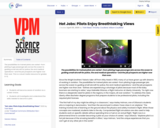
Conditional Remix & Share Permitted
CC BY-NC
The possibilities for trained pilots are varied—from piloting huge passenger jets across the ocean to guiding small aircraft for police, fire and medical operations—and the job prospects are higher now than ever.
This is a visual media resource for grades 6-12.
- Subject:
- CTE
- Career Connections
- Cross-Curricular
- STEM/STEAM
- Material Type:
- Visual Media
- Provider:
- VPM
- Date Added:
- 01/06/2020